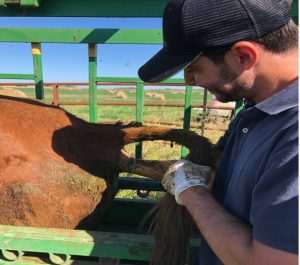AB Direct - Steers
Rail: ---
AB Direct - Heifers
Rail: ---
US Trade- Steers
Rail: 290.00 (IA)
US Trade - Heifers
Rail: 290.00 (IA)
Canadian Dollar
0.02

ABP Research Showcase Highlights | Improving the accuracy of forage digestibility analysis
This is the ninth and final installment in a series of articles highlighting a selection of ABP-supported research projects that were featured at our Research Showcase in February 2023. Find the previous articles here.
Whether you’re a beef producer or a researcher, accuracy is everything when it comes to analyzing the nutritional content of forage.
And while Near Infrared Reflectance Spectroscopy (NIRS) is showing promise in determining nutrient content and digestibility, there’s still plenty of work to be done before we can rely on this method for the highest-quality information.
Using infrared light, NIRS can evaluate the fibre, protein, energy, and mineral content of forage significantly faster and for less money than the more frequently used wet chemistry methods of analysis.

The desired accuracy, however, requires “good sample collection and storage and the consistent drying, grinding, and mixing of samples before analysis,” according to an Alberta Agriculture publication.
“The calibration set used must be developed from an adequate number of wet chemistry samples, similar to those being analyzed.”
Acknowledging these requirements, a group of researchers wanted to develop NIRS calibrations specific to high-forage diets for beef cattle to accurately predict the nutritional composition, nutrient intake, and digestibility of these diets.
“We saw that there was an increased use of calibrations in the dairy area for estimating uNDF (undigestible neutral detergent fibre),” said Gabriel Ribeiro, Saskatchewan Beef Industry Chair and assistant professor at the University of Saskatchewan.
“In the dairy systems, they’ve been using that as a routine in their diets, but we didn’t have calibrations for beef under grazing conditions.”
This study was led by U of S graduate student Jenilee Peters, who worked with Ribeiro as a master’s student and is continuing this research as part of her doctoral studies.
Building a baseline through a range of samples

To develop these calibrations, researchers needed forage and fecal samples from cattle fed a variety of forage-based diets.
The researchers conducted three total collection digestibility studies, where beef females were fed 12 different diets that represented a range of forage types, quality, and maturity.
To represent varied grazing systems, the researchers also collected fecal samples from steers grazing different annual and perennial forage mixtures over the course of two growing seasons.
The different diets allowed for a range of neutral detergent fibre (NDF) and uNDF content, which affects digestibility, Ribeiro explained.

“We wanted to have that variation in the samples so we could develop calibrations that would be more broadly applied and then be more useful,” he said.
The fecal samples were dried and ground before being scanned by a device called a monochromator. The samples were also analyzed using wet chemistry methods for uNDF, organic matter, acid detergent fibre (ADF), acid detergent lignin (ADL), amylase-treated ash-corrected neutral detergent fibre (aNDFom), nitrogen, phosphorus, and calcium.
The ADL and uNDF levels were used as internal markers in the calibrations to predict the composition of both forage and feces samples.
“We’re using those internal markers to compare to the total collection digestibility and also to compare to the predictions we made with the NIRS scan and see how close they were, and which ones are better to predict the digestibility,” said Ribeiro.
Fast, accurate predictions possible through NIRS
Together, the researchers used all this data to create the calibrations, then evaluated their quality through prediction equations for fecal composition, nutrient intake, and digestibility. This showed that the calibrations for ADL, uNDF, and the other components analyzed had a moderate to high degree of accuracy.
“We can conclude that the NIRS predicted fecal composition of cattle fed those high-forage or grazing diets with high accuracy and precision,” said Ribeiro.
“The accurate prediction of those internal markers could be used to calculate intake, so now we have a way to figure out the concentration of uNDF and lignin in feces on animals on pasture. If we consider that those are good markers for intake, then we would already have a way to estimate intake in most grazing conditions.”
This research is ongoing, as the team plans to collect more samples from a range of forage species and grazing systems to improve the existing calibrations and expand this method of analysis.
“We definitely think that we have good calibrations, but as we keep working on this and keep adding more fecal samples from different grazing conditions, that is going to be even more broadly applicable, and it’s going to improve in time.”
This study was partially funded by Alberta Beef Producers. To learn about more ABP-supported studies and find fact sheets for completed and in-progress projects, visit our Research and Development webpage.
Leave a Comment
Add abpdaily.com to your home screen
Tap the menu button next to the address bar or at the bottom of your browser.
Select ‘Install’ or ‘Add to Homescreen’ to stay connected.



Share this article on
About the Author
Piper grew up on a purebred cow-calf operation in Southern Alberta, and she studied English and history at the University of Alberta and journalism at the University of King's College. She has written for industry publications for more than a decade and is currently the Digital Content Specialist for Alberta Beef Producers.